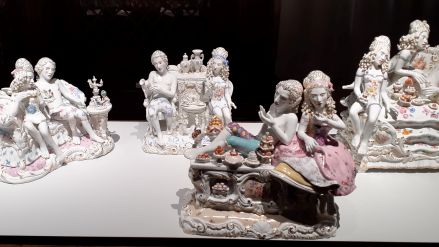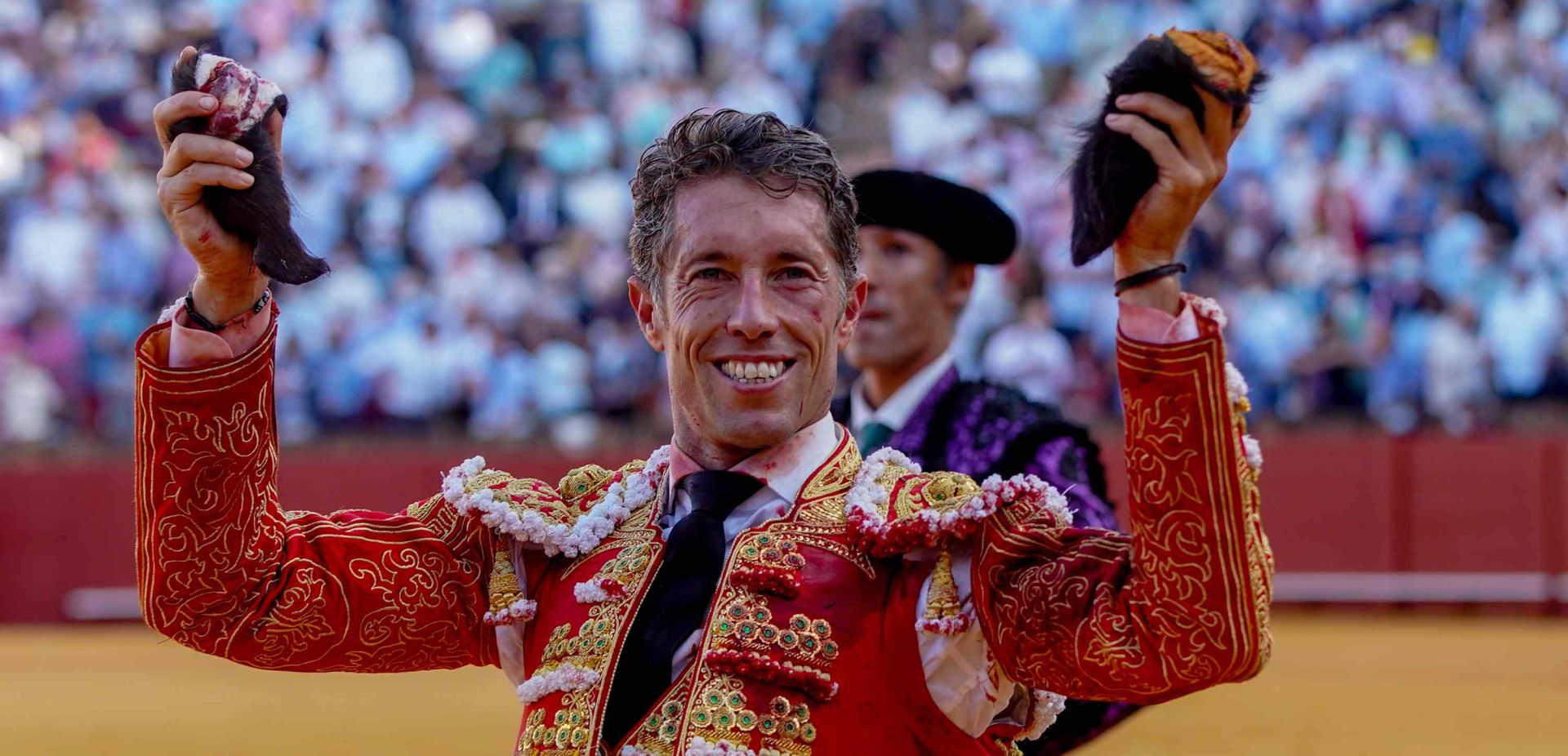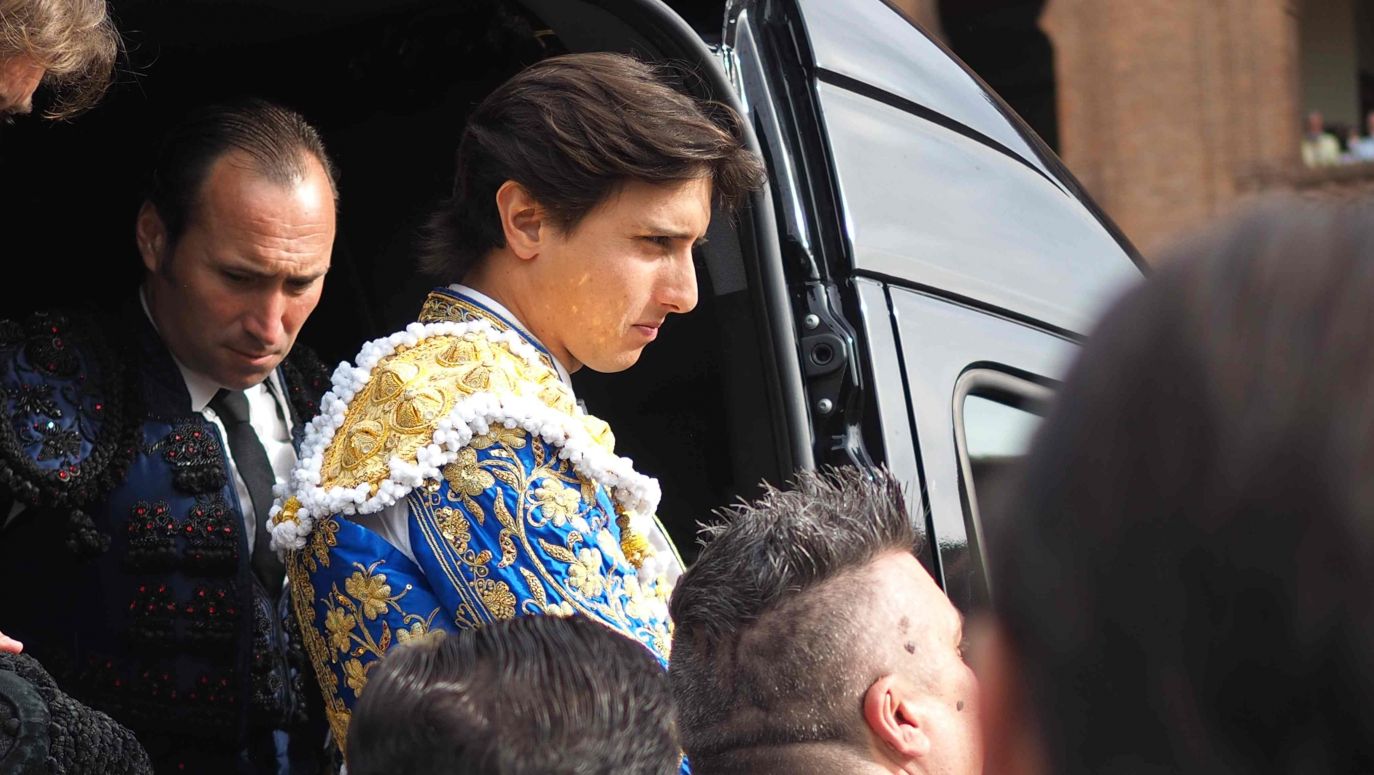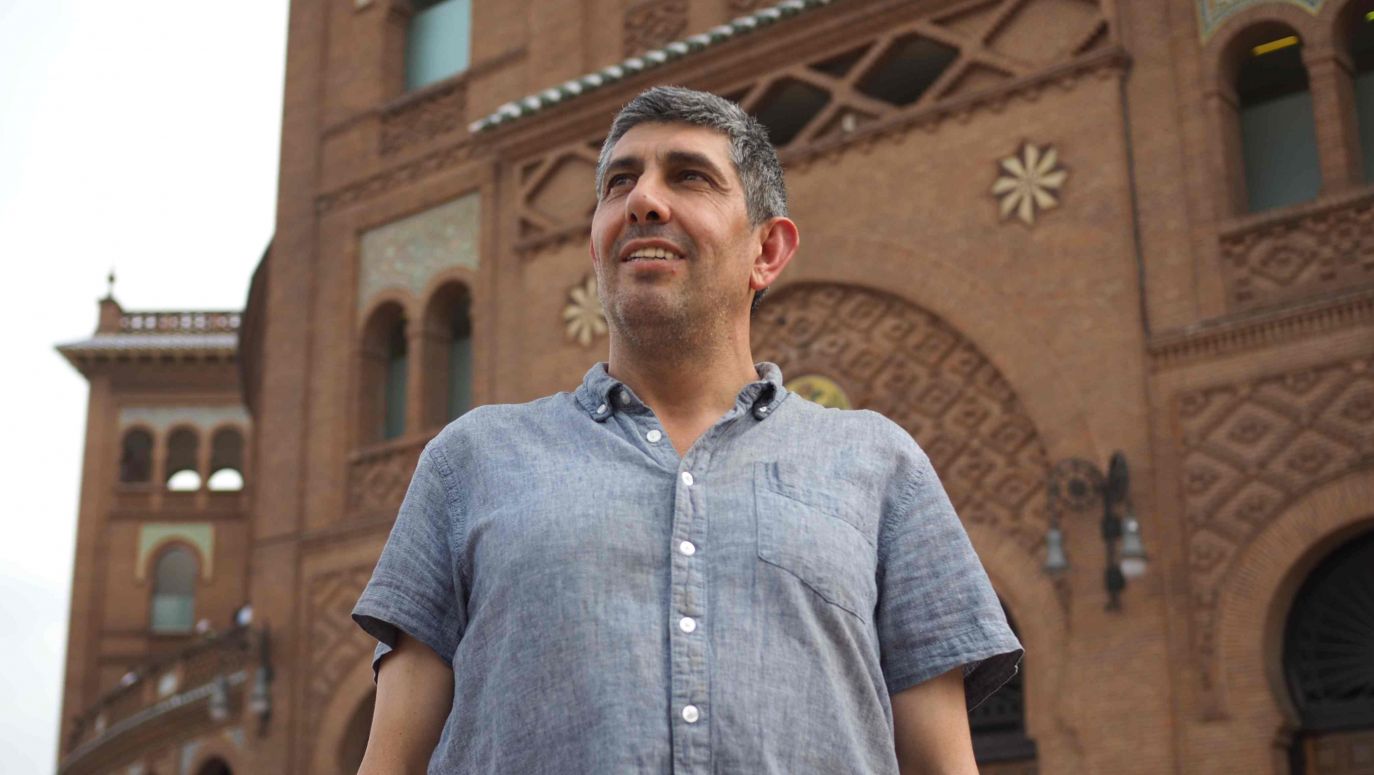Look, now he will kill a bull. You will see if you like it
08.06.2022
After a sequence of sweeping moves, the aim of which is to make the bull respond to his directions, the matador pulls out his sword. The onlookers most appreciate these matadors who put the animal to death with a single thrust of their sword.
The Madrid underground train, line number 5, is moving steadily. Passengers stare at their smartphone screens and listen with indifference as the voice from the speaker system intones the names of the stops while reminding them to put their masks on. Crowds gather by the door as it reaches the Las Ventas stop. Many get up from the seats, some holding binoculars, others carrying small cushions striped in Spanish colors or plain but trimmed with a red and yellow ribbon. The cushions have a purpose -- to ensure that their seats on the stone steps of Madrid's great bullring, Las Ventas, are more comfortable.
I emerge from the underground straight into the noisy square. Aficionados , ardent fans of tauromachy (the art of bullfighting) gather in groups around the monumental 19th century, neomudéjar style bullring. It is Spain's largest bullring holding 23,798 spectators, making it the third in the world, after those in Mexico's capital and in Valencia, Venezuela. The fans wander around the outskirts of the arena, chatting as they stop to view the monuments of famous bullfighters, and visit stalls selling drinks and roasted almonds. Scalpers mingle in the crowd. "Tickets for today, tickets for today. In the shade and in the sun," they recite, accosting passers-by.
In May, Madrid celebrates the feast of its patron saint St. Isidore the Farmer. Marking the occasion, bullfights will be held in the Las Ventas arena every day for almost a month. This year, nearly 180 animals are scheduled to die in 29 scheduled events. The last bullfight in honour of St Isidore will take place on Sunday, June 5, 2022.
"Today there are very famous names on the posters, so the tickets have been sold out. Same for tomorrow. But you still should be able to get tickets for the weekend," I am advised by an elderly man, who is sitting with his wife on one of the benches next to the arena. He is surprised when I ask how often they come to watch the bullfighting."We come every day, we have a pass, " he explains. As 6pm strikes and the arena doors open, he and his wife make their way towards their seating sector.
For another hour, the Las Ventas’ terraces overlooking the square are abuzz. However, punctually at 7pm, the noise shifts inside the monumental building, while outside, all that can be heard is the drone of cars speeding down the multi-lane Alcalá Street.
From grandma to grandson
"If you want to know what a bullfight is, you'd better see it now because the day will come when they will ban it,” Spanish people, fans or otherwise, will tell you.
The prognosis is more than a probability. The anti-bullfighting movement has been growing stronger for years, not just in Spain, but in the other countries where the fights are held.
Last week, in Mexico City, site of the world's largest bullring (capacity 40,000-plus), a judge issued a temporary ban on organising bullfights. His decision followed a lawsuit filed by the Justicia Justa group. As a result, all scheduled bullfights in the arena have been cancelled until the case is resolved.
In Spain, numerous animal welfare organisations are campaigning to ban bullfights. Polls show that a majority of Spaniards (slightly more than half of the respondents) support the introduction of such a ban. Spanish Ministry of Culture and Sports data show that while in the period 2018-2019 only 8 per cent of Spaniards attended a bullfight, 25 per cent of the population, i.e. some 11 million, declare they remain interested in such events.
"I wouldn't call myself an aficionado," says Elías Casado Manso, my guide to the world of tauromachy
"I go to bullfighting several times a year when there is a festival in Madrid and it includes a performance by a bullfighter I like to watch, or during the San Miguel festival in my hometown of Guadarrama. However, there are those who buy season tickets, follow the results and the latest news, have their favourites and support them almost fanatically. These, he explains, are the real aficionados, as we wait for the Monday novillada with picadors.
In the novillada, young bullfighters fight three-or-four-year-old bulls weighing a maximum of 540 kg. During one of the three stages of the fight, they are joined by a pair of picadors on horseback, who tame or weaken the bull using a sharp lance. In other versions of the novillada, the young bullfighter appears without picadors (against two-to-three-year-old bulls). Then there is the rejoneo, in which the principal fighter, the rejoneador, is mounted on a highly trained horse. The most popular form is the corrida, where the participating bullfighters are more experienced and confront four-to-six-year-old animals that must weigh at least 460 kg.
Elías says that when he sits as a spectator in the arena, he has no qualms about the bull being struck repeatedly or for the bullfighter who plays with his own life. "It's something I've known since childhood, something I grew up with," he says. He pulls out his phone and hihglights a black and white photo that was taken a few decades ago. It shows an old lady, a scarf tied under her chin, with a bunch of kids around her. "This is my grandmother who took me, my sisters, brother and cousin to bullfighting in our city. The smallest one is me". He points to himself in the the picture. He looks no more than three years old. The children are dressed in festive clothes: white blouses, checkered skirts or pants. "Today Guadarrama has 17,000 residents, but decades ago, when there were 4 or 5,000 thousand of us, and bullfights were organised in the city, everyone was going to watch them. This is where families and neighbours met, everybody took their children too," he recalls.

Can there be anything more pleasant?
see more
When we walk the streets of Guadarrama, less than 50 km from Madrid, Elías shows me pieces of metal placed in the asphalt. These are special hooks that facilitate the installation of protective barriers when bull runs take place in the town. They are exectly the same as those for which Pamplona is famous for. In Guadarrama, it is easy to find young men who take part in these runs or in the so-called recortes competitions, where they confront a bull with their bare hands, trying their best to avoid meeting its horns.
"What makes me go to bullfighting? Atmosphere. You'll see for yourself. It is unique in Madrid. When the matador stands in front of the bull in the arena, the orchestra stops playing and the audience goes silent," says Elías.
Greeting of the matador
Before the Las Ventas opens to admit the fans, bars and other venues in the adjacent streets are packed. The Los Timbales restaurant, popular with bullfighters, is decorated with tiles featuring paintings of bulls and matadors. There are mementoes of Manuel Rodríguez "Manolete", an all-time star bullfighter, who died in 1947 as a result of wounds sustained in the Linares arena. In the lead up to the bullfights, it is difficult to find a free table, much less a standing place at the bar here.
The crowd is also thick in front of the arena gates through which bullfighters and their teams (cuadrillas ) enter. Usually, three matadors, i.e. those who face the bull with cape and then sword, appear consectively during a corrida. Each is accompanied by two picadors and three banderilleros. The latter are the men who place a pair of banderillos (decorated wooden sticks with spiked ends) into the bull.
They are usually driven into the arena in buses with tinted windows. In gala costumes, they squeeze through the throng as fans beg them for photos and autographs. "Good luck, maestro," the crowd shouts, the customary salute to the matadors. The matadors are easy to recognise. Among their team, they stand out, each wearing the golden, shimmering outfit known as the suit of lights. The more famous matadors are featured on the event's poster, the bigger crowds jostle to see them in front of the arena gates.
On a day when the tickets have been sold out down to the last seat, Andrés Roca Rey, a young Peruvian famous for taking risks and renowned for his close-encounter confrontations with the bull and the daring passes he makes with his muleta is scheduled to appear. When his bus arrives, the crowd surges barely letting him dismount. Everyone wants a photo with him. A teenager who came with a miniature matador cape purchased in a gift shop squeezes through the crowd so his idol can autograph it. With the help of the police, Roca Rey finally manages to cross the threshold of the arena. Already, the crowd has turned its attention to another matador. People shout: "He's coming Manzanares!"
José Mari Manzanares, a matador famous in Spain and thorughout the world of bullfighting, is from Alicante. He is the son of a legendary bullfighter, who carried the same name.
Ultras from Sector 7
By 7pm, the aficionados , who previously had been hanging around the square waiting for the cuadrillas , have finally entered the arena. Older men in checkered shirts and hats or caps. Younger men in skinny trousers, loafers and baggy pastel shirts. There is no shortage of ladies either. Some in sportswear, others more stylish, in long dresses, hats and high heels, fans in their hands.
The arena is divided into shaded and sunny sectors. Las Ventas, opened in the 1930s, was designed in such a way that, thanks to its large number of seats, ticket prices could be reduced. Today the most expensive seats (in the shade and closest to the actual arena) cost around 200 euros but the cheapest ones can be bought for just over eight.
Celebrities, public figures, and those with fat wallets, usually occupy the best seats in sectors 9 and 10. The seats in sector 7 are where the most vocal audience can be found. Here sit the people who won’t hesitate to shout and whistle at a bullfighter, picadors, or the whole cuadrillas . Their loud, rude comments can be heard all over the arena. The online newspaper "El Español" calls them "Sector 7 Ultras". Among them, the most famous character is Faustino Herranz, known as "El Rosco". For almost five decades, he has been buying the same 38th seat, in the 12th row. A neighbouring seat has been occupied since 1988 by Yolanda Fernández, a history professor.

Cats have a voice too. "I've just finished another Russian invader," reveals a licking tomcat.
see more
"Pillows, pillows for stone seats, " shout the arena attendants, who offer pillows for hire to the viewers. The onlookers rush to their seats, clutching their programmes, which include short biographies of bullfighters, the names of other people in the cuadrillas, and the names of the bulls. In adjacent rows, gentlemen light up their cigars. The father, who brought his toddler along, not an uncommon occurrence, tries to settle him down comfortably on the stone steps.
Punctually at 7pm, the event chairman (presidente) signals the start the show. The heroes of the evening enter the arena together.
Each of the three matadors has to face two bulls. When the horned beast comes running into the arena, members of the matador's team (cuadrilla ) attract the bull's attention with heavy pink and yellow capes capotes (capote). As they do, the matador observes how the animal reacts and behaves.
The show is divided into three stages or acts. During the first stage, picadors on horseback tease the bull. In the second stage, banderilleros harpoon sharp-ended, decorated with brightly coloured tissue paper banderillas into the bull's back. When they raise their arms, holding the banderillas high in their hands, they look like birds getting ready to take off. The movement attracts the bull's attention and he attacks them. The banderillero evades the bull’s charge, at the same time lodging the sharpened banderillas in the charging bulls neck and shoulders. Done gracefully and flawlessly, with both harpoons lodged in the right place, and he earns the spectators' applause. The third stage consists of the matador's performance. With a theatrical gesture, he takes off his headdress, throwing it on the sand. He approaches the bull with his red muleta. "It is more appreciated when a matador holds a muleta in his left hand, because it is considered more difficult. The bull following the matador should not touch the muleta, " Elías explains.
After a sequence of sweeping moves, the aim of which is to make the bull respond to his directions, the matador pulls out his sword. Here again, the onlookers most appreciate these matadors who put the animal to death with a single thrust of their sword.
This Monday novillada’s audience is very lively. There are moments of horror. A 22-year-old matador from Murcia is battered by a bull. But he rises again. "Look, now he'll kill the bull. You'll see if you like it." It is the man in the seat in front of me encouraging his toddler son to watch the show.
The matador executes the sword blow with precision. The bull falls on the sand. The crowd cheers, white handkerchiefs appear over the arena. This is a sign for the chairman that the audience demands the matador's skill be recongnised by the award of one or two of the dead bull’s ears. Perfection can also earn a matador the bull’s tail but this rarely happens. Should a matador be awarded two ears, his fans are allowed to carry him out of the arena on their shoulders.
Today, the presidente is unmoved. A team of mules takes a dead animal out of the arena. His meat will be sold to restaurants. People whistle, hum, shout for the chairman to get out of the arena. "Did he forget it's a novillada? How could he not give the boy an ear?," the father of the toddler is upset. He encourages his son to protest loudly as well.
The matador, encouraged by the crowd, makes an honorary circuit, striding around the arena, accepting the flowers thrown at him, while flinging back the caps and hats that the crowd have flung down to him. "Sometimes the audience gives a matador a rooster instead of flowers," Elías tells me.
When the next matador enters the arena, emotions are still high. Eventually the audience quietens down. Then someone from Sector 7 says loudly: "Presidente is stupid!", and his voice carries around the arena. Spectators whistle and hum again.
Presidente finally rehabilitates himself in the eyes of the public, and grants Álvaro Alarcón, from Toledo one ear of the first bull he kills. When Alarcón kills the second animal, to general applause, the presidente displays a single white handkerchief once more. It means the bullfighter will get another one ear. But the onlookers do not stop there. "Next, next!, " they scream and they get their way. The matador gets a pair of severed ears. The crowd goes wild and more and more people come out onto the arena sand, eager to carry Alarcón out on their shoulders.
It is not often during a novillada that the great doors to Madrid’s La Ventas square open in front of the matador.
The celebration of the matadors' performance continues even after the fights in the arena have concluded. The fifteenth evening of the St. Isidore feast at Las Ventas is a triumph for 25-year-old Mexican Leo Valdez, who also was rewarded with one ear. Now, with the bullfight over, a crowd of fans await him outside. "Long live Leo, long live Mexico", a group of young women chants.
Manuel Escribano, 38, from Gerena, Andalusia, can barely squeeze himself through the crowd into the bus waiting for him. This evening, he captivated the crowd with his spectacular performance. He awaited the approach of the bull on his knees, cape in hand, before planting his banderillas into the bull's back with grace and precision. The audience demanded an ear for him as well but the presidente did not accede to their demands. This earned him whistles and sounds of derision. To compensate Escribano, the spectators accorded him an honour lap of the arena and he was then greeted warmly outside.
Fear of failure, Fear of the bull
Many bullfighters have a celebrity status. Gossip magazines write about them, and paparazzis follow them everywhere. The young generation of bull slayers are eager to contribute to social media. Roca Rey is active on Instagram. There he publishes not only photos from his bullfights but his visits to a tailor specialising in bullfighter costumes, family pictures, and others showing him travelling or sunbathing. In interviews, he responds shyly to the curious when questioned about his earnings or matters of the heart.
He once admitted to the Onda Cero radio station that he remembers many of bulls he has fought. "The bullfighter’s fear is very strong. You feel fear of failure and fear of the bull. Because the bull can not only hurt you. The bull can kill you, " he said.
And this is true. Bulls can and do kill matadors. In 2017, 37-year-old Iván Fandiño died in an arena in France. He stumbled over his cape with tragic consequences. The bull's horn pierced his lung and stomach. The arena medics rushed to transport him to hospital but on arrival all the doctors could do was issue a death certificate. In 2016, Víctor Barrio was killed on the arena in Teruel. He was 29 years old. He suffered a perforation of his chest in the confrontation with the bull. In 2011, Juan José Padilla miraculously escaped the same fate. The bull hit him in the skull with its horn. Padilla lost an eye. He returned to the arena five months later, with a black headband, which is why he is nicknamed now the Pirate.
Although today the bull arenas have well-equipped operating rooms (Las Ventas has two) and surgeons on duty, the fight with the bull is still a deadly game.
More and more bans
The bullfighting tradition can be traced back to Roman times, or even earlier to the Bronze Age. In modern Spain, there are over a thousand breeders of brave bulls (toro bravo). Half a million hectares of land are allocated to raising them. It costs a breeder between 4,500 and 5,000 euros to raise and ready a five-year-old toro bravo for a fight.
Will the 21st century be the last in which matadors confront the bulls? "I suspect so," says Elías. "Maybe they will just ban killing bulls in the arena, but that would mean the end of tauromachy anyway. Such a corrida will cease to be attractive, because everyone will be able to do it," he believes.
In some places, bullfights without killing animals already take place but this has no appeal for the real aficionados. In France, for example, the Camargian corrida features bulls that are decorated with ribbons and flowers, allowing the daredevils a limited time in which to tear them off. Some Spanish villages stage so-called recortes, where a man in a tracksuit enters the arena and runs after the bull. The aim is that the animal should not hurt him. However, those who do this have not been trained, no technique or skills are required, It's just fun for everyone. Very different then, is the case with professional bullfighters. They must learn the art of killing a bull and how make an artistic spectacle of it.
In Madrid, just before this year's fiesta in honour of St. Isidore, several dozen activists from the AnimaNaturalis organisation and the anti-bullfighting CAS International protested in front of the Ciebeles Palace, demanding a ban on organised bullfighting. The protesters claimed that what bullfight fans consider an entertainment is in reality animal abuse that causes unnecessary suffering. "Madrid is synonymous with diversity and this is what we celebrate during the holidays. Corrida is a phenomenon that destroys society and the majority finds it disgusting," commented Jaime Posada, the AnimaNaturalis coordinator in Madrid. Protesters demanded an immediate end to subsidising bullfighting and urged that children not be allowed to attend such events.










